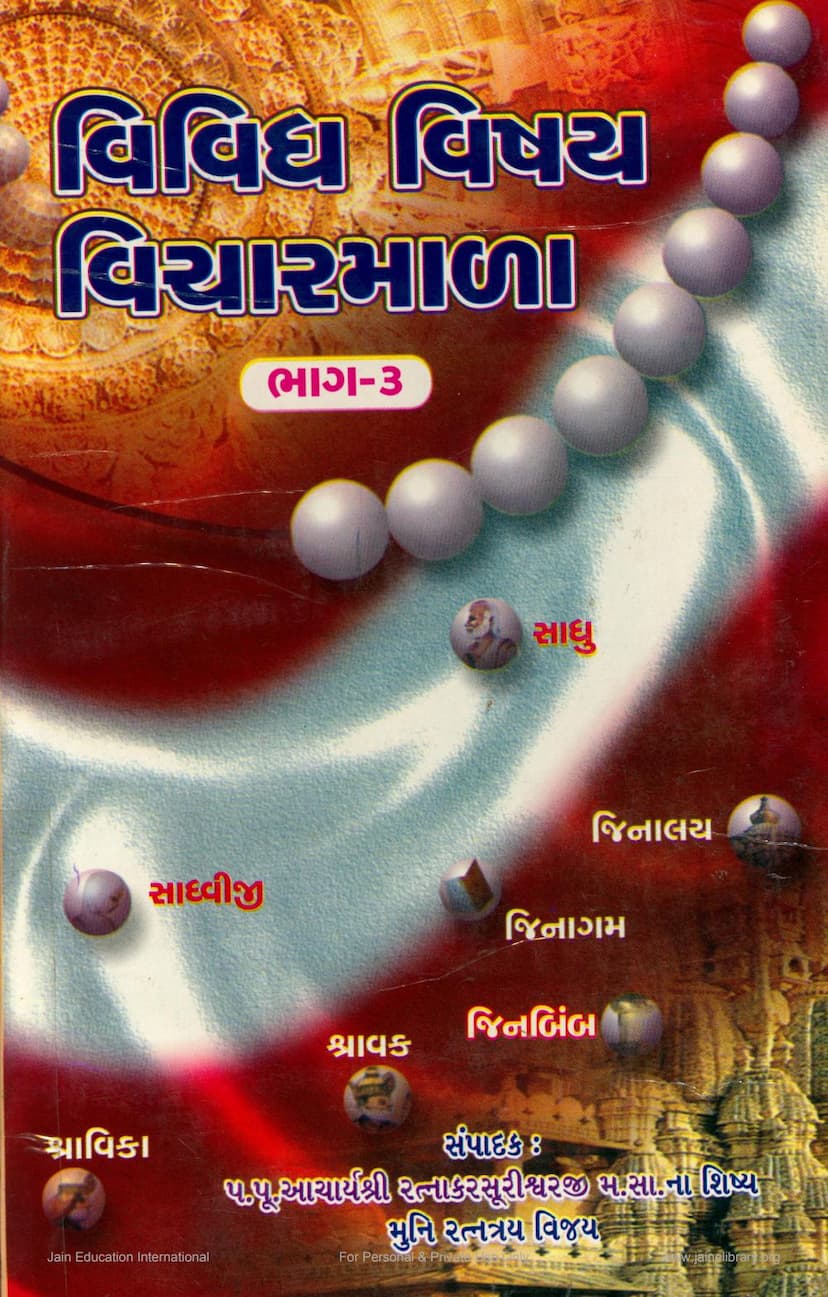Vividh Vishay Vicharmala Part 03
Added to library: September 2, 2025

Summary
Here's a comprehensive summary of the Jain text "Vividh Vishay Vicharmala Part 03":
Book Title: Vividh Vishay Vicharmala Part 03 (Various Subjects Thought-Garland, Part 03) Author: Muni Ratnatray Vijay (Disciple of Acharya Ratnakarsurishwarji Maharaj) Publisher: Ranjanvijay Jain Pustakalay Catalog Link: https://jainqq.org/explore/005489/1
This book, "Vividh Vishay Vicharmala Part 03," is part of a larger series (Parts 1-8) compiled by Muni Shree Manivijayji Maharajsaheb, based on Jain Agamas and scriptures. The series was initially published about 40 years prior and was out of print. Muni Shree Ratnatray Vijayji Maharajsaheb has undertaken the task of re-editing and re-publishing these valuable texts for the benefit of the Jain community.
Core Purpose and Content:
The "Vividh Vishay Vicharmala" series aims to present the vast and profound knowledge of Jainism in a simplified and accessible manner. The original scriptures are often in Sanskrit and Prakrit, making them difficult for many to understand. This series bridges that gap by explaining complex Jain philosophical concepts, practices, and narratives with clarity.
This specific volume, Part 03, is described as a collection of sixty-four topics and acts as a Jainism reference index. It covers a wide array of subjects related to the Jain Dharma, providing details on most of the important topics within the faith. The book is intended to be useful for all ages, from children to adults, and is considered an invaluable resource for Jain monks and nuns.
Key Themes and Topics Covered (as per the table of contents and descriptions):
The provided text includes a detailed table of contents, showcasing the vastness of the information presented. While the summary cannot go into the depth of each of the 64+ topics, here are some of the major categories and examples of subjects found in this part of the series:
-
Classifications and Types (enumerated by numbers): A significant portion of the book is dedicated to categorizing various aspects of Jainism, spiritual practices, and even general knowledge into numerical lists (e.g., "One Type," "Two Types," "Three Types," and so on, up to "Sixty-Four Types"). This structure is a hallmark of Jain literature, which often categorizes concepts extensively.
- Examples of topics covered under these classifications:
- The nature of Devotion, Guru, and Dharma.
- Types of Deity Worship.
- Definitions and characteristics of a Guru (including distinguishing between good and bad gurus).
- Detailed descriptions of Dharma and its various forms.
- The essence of a Shravak (lay follower) and their practices like Samayik, Pratikraman, Paushadh.
- The rarity of human birth and the importance of realizing its potential.
- The nature of Samyakva (right faith) and Mithyava (wrong faith), along with their sub-categories.
- Discussions on virtues, vices, and practices for self-improvement.
- Detailed explanations of the 24 Tattvas (fundamental realities) in Jainism.
- Discussions on various aspects of daily life, ethics, and conduct.
- Topics like the significance of the Purushartha (human endeavor), time, charity, and the 32 auspicious characteristics.
- Discussions on intellect, foolishness, permissible and impermissible actions, and expiation (Prayashchitta).
- General knowledge topics, including:
- Sāṁudrika Shastra (physiognomy/palmistry)
- Omens and superstitions (e.g., sneeze omens, lizard falling on the body)
- Historical anecdotes (e.g., Karnavati Nagari and Siddharaj)
- Geographical information (e.g., length of rivers, types of land)
- Societal information (e.g., UNO and its Secretaries-General, major world religions and their followers, major world castes, notable world libraries, the 20th century and books).
- Examples of topics covered under these classifications:
-
Stories and Illustrations: The book is rich with stories and examples (more than 125 in Part 1, and numerous more in other parts) that effectively clarify and illustrate the discussed subjects, making them easier to grasp and remember.
Significance and Appeal:
The "Vividh Vishay Vicharmala" series is highly valued because it:
- Democratizes Jain Knowledge: Makes complex Jain philosophy and practices accessible to a wider audience, regardless of their prior scriptural knowledge.
- Provides a Comprehensive Reference: Serves as a ready reckoner for various Jain concepts, making it an essential tool for students, scholars, and practitioners.
- Preserves Valuable Literature: Rescues important Jain texts from obscurity and makes them available to current generations.
- Enrichment for Devotees: Offers a treasure trove of knowledge for those seeking to deepen their understanding of Jain Dharma.
In essence, "Vividh Vishay Vicharmala Part 03" is a meticulously compiled and re-edited volume that aims to illuminate the multifaceted nature of Jainism, providing a structured and informative resource for spiritual growth and intellectual understanding.